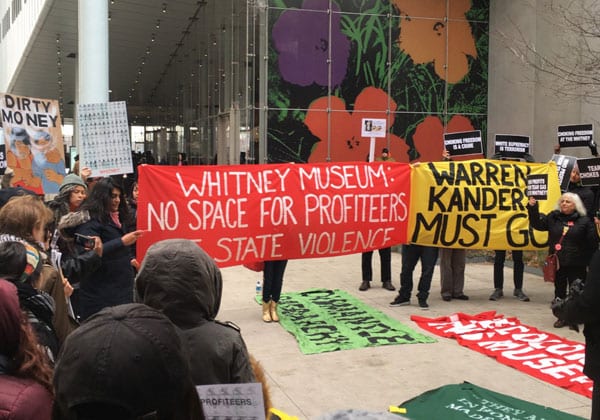
December 9, 2018; Hyperallergic
The Whitney Museum of American Art found itself hosting an unexpected artist this week when a small exhibit was installed to introduce museumgoers to Whitney Museum director Adam Weinberg’s defense of its board’s vice chairman Warren B. Kanders. Hyperallergic reported on November 27th that Kanders manufactured tear gas and smoke grenades used on asylum-seekers at the border in November, but his offenses go back much further:
In 2015, Hyperallergic reported on Kanders’ stake in the militarization of United States police forces through his role at Safariland, LLC, whose weapons are also utilized by Ferguson, Oakland, and Baltimore police. According to Bloomberg, Kanders is the Chairman and Chief Executive Officer of Safariland and has been affiliated with the company since 1996. He purchased the corporation in 2012 for about $124 million from the UK-based BAE Systems, which is the largest defense contractor in Europe and the third-largest in the world.
The humble but powerful exhibit followed close on the heels of a large Decolonize This Place protest inside the Whitney and was installed by Rafael Shimunov with the group Art v. War. Shimunov’s stuck around for only a half hour before he slipped away quietly but he reported that around 70 patrons had already viewed the exhibit, which included two paintings and some text that read:
The Whitney Museum of Art’s Vice Chairman owns weapons manufacturers that supply Trump’s attacks on families and children seeking asylum.
A movement of artists have [sic] emerged to refused to allow our institutions to side with hate
Search #WhitneyTearGas and sign the petition.
Shimunov is himself a refugee from Uzbekistan, and he found it offensive that the Whitney Museum recently mounted a celebrated exhibition of Indigenous Latinx practices while Kanders was in a position of power within the museum.
More than 100 Whitney staff have signed a letter expressing the same sentiments. It reads as follows:
Sign up for our free newsletters
Subscribe to NPQ's newsletters to have our top stories delivered directly to your inbox.
By signing up, you agree to our privacy policy and terms of use, and to receive messages from NPQ and our partners.
To the leadership of the Whitney Museum:
We are writing to convey our outrage upon learning that Whitney Vice Chairman Warren Kanders’s company, Safariland, is the supplier of the tear gas recently used to attack asylum seekers at the US border, and our frustration and confusion at the Whitney’s decision to remain silent on this matter. We understand this is not new information to leadership, or likely to the rest of the Board, but many of us learned of the connection via the Hyperallergic article published November 27, 2018. We also understand the nuanced and vital relationship any nonprofit has to its Board. But we believe that this recently aired knowledge about Mr. Kanders’s business is demonstrative of the systemic injustice at the forefront of the Whitney’s ongoing struggle to attract and retain a diverse staff and audience. And because we feel strongly about this, we believe it is our responsibility to speak to this injustice directly, even as the Whitney has chosen not to. To remain silent is to be complicit.
First and foremost, some of us are deeply connected to the communities that are being directly impacted and targeted by the tear gassing at the border. For the Whitney not to acknowledge that this news may impact its staff is to assume we are separate from the issue, that it is happening somewhere else to some other people. Many of us feel the violence inflicted upon the refugees—and against mostly-[people of color] protesters in Ferguson, and mostly-Indigenous protesters of the Dakota Access Pipeline, just two of many other instances of militarized tear gassing of unarmed citizens—much more personally than it seems to affect leadership. For many of us, the communities at the border, in Ferguson, in the Dakotas, are our communities. We read the Hyperallergic article and felt not annoyed, not intellectually upset—we felt sick to our stomachs, we shed tears, we felt unsafe.
As of Thursday morning, November 29th, we have received no official internal communication addressing the Hyperallergic article. A small group of us were informed of the Whitney’s policy not to comment on the personal business of Trustees, but this is public knowledge, not a private matter of Mr. Kanders’s. Setting aside the personal reactions of staff, this choice makes it difficult for staff to function well professionally. Should protests from the public or questions from visitors arise, our visitor-facing staff will be the ones answering them. Leadership choosing not to give a public (or even internal) statement displaces the labor to our visitor-facing staff, who are, generally speaking, our most diverse and lowest paid staff. You will recall similar complaints surrounding the Dana Schutz protests—and we are disappointed that the response by the leadership of this institution remains the same.
So many of us are working towards a more equitable and inclusive institution. We work to bring in artists who are immigrants and artists of color to the collection. We create programming for youth and families who are affected by current immigration policy. Upon learning of Kanders’s business dealings, many of us working on these initiatives feel uncomfortable in our positions. We cannot claim to serve these communities while accepting funding from individuals whose actions are at odds with that mission. This work which we are so proud of does not wash away these connections.
They conclude the letter with:
Continuing to accept funding—even, or perhaps especially transformative funding—from individuals who are knowingly complicit in the injustices committed on our own land and across our borders is negative peace. We demand positive peace.
Thank you, and we look forward to a productive dialogue and definitive change.
As do we all.—Ruth McCambridge













